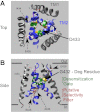Structure and activity of the acid-sensing ion channels
- PMID: 22843794
- PMCID: PMC3469599
- DOI: 10.1152/ajpcell.00188.2012
Structure and activity of the acid-sensing ion channels
Abstract
The acid-sensing ion channels (ASICs) are a family of proton-sensing channels expressed throughout the nervous system. Their activity is linked to a variety of complex behaviors including fear, anxiety, pain, depression, learning, and memory. ASICs have also been implicated in neuronal degeneration accompanying ischemia and multiple sclerosis. As a whole, ASICs represent novel therapeutic targets for several clinically important disorders. An understanding of the correlation between ASIC structure and function will help to elucidate their mechanism of action and identify potential therapeutics that specifically target these ion channels. Despite the seemingly simple nature of proton binding, multiple studies have shown that proton-dependent gating of ASICs is quite complex, leading to activation and desensitization through distinct structural components. This review will focus on the structural aspects of ASIC gating in response to both protons and the newly discovered activators GMQ and MitTx. ASIC modulatory compounds and their action on proton-dependent gating will also be discussed. This review is dedicated to the memory of Dale Benos, who made a substantial contribution to our understanding of ASIC activity.
Figures



References
-
- Adams CM, Snyder PM, Price MP, Welsh MJ. Protons activate brain Na+ channel 1 by inducing a conformational change that exposes a residue associated with neurodegeneration. J Biol Chem 273: 30204–30207, 1998 - PubMed
-
- Adams CM, Snyder PM, Welsh MJ. Paradoxical stimulation of a DEG/ENaC channel by amiloride. J Biol Chem 274: 15500–15504, 1999 - PubMed
-
- Akopian AN, Chen CC, Ding Y, Cesare P, Wood JN. A new member of the acid-sensing ion channel family. Neuroreport 11: 2217–2222, 2000 - PubMed
-
- Andrey F, Tsintsadze T, Volkova T, Lozovaya N, Krishtal O. Acid sensing ionic channels: modulation by redox reagents. Biochim Biophys Acta 1745: 1–6, 2005 - PubMed
Publication types
MeSH terms
Substances
Grants and funding
LinkOut - more resources
Full Text Sources
Research Materials

